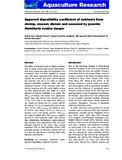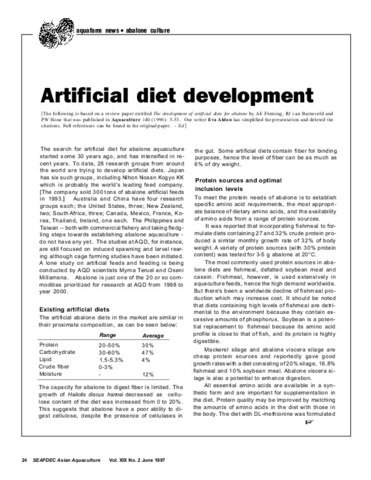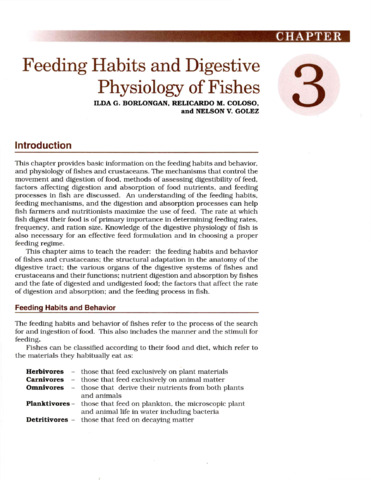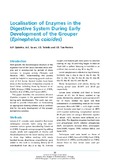Apparent digestibility coefficient of nutrients from shrimp, mussel, diatom and seaweed by juvenile Holothuria scabra Jaeger

ดู/
Request this document
วันที่
2014ผู้เขียน
Page views
172เมตาดาต้า
แสดงระเบียนรายการเต็มCited times in Scopus
Share
นามธรรม
The ability of Holothuria scabra to digest nutrients, such as organic matter (OM), protein and carbohydrate from animal and plant feed ingredients was investigated. Four test feeds prepared by mixing sand with single ingredients from animal sources (shrimp and mussel) and plant sources (diatom and seaweed) were fed to H. scabra to estimate apparent digestibility coefficient (ADC). The total assimilated nutrient (TAN) increased with ADC, whereas ingestion rate (IR) varied slightly among the feeds suggesting that ADC might be a good indicator of nutrient availability to H. scabra. The ADCOM of shrimp and mussel was significantly higher than that diatom and seaweed: 86.2%, 77.1%, 55.1% and 32.3% respectively. ADCprotein was similar for shrimp (88.7%), mussel (84.8%) and diatom (75.2%), but significantly lower in seaweed (34.4%). ADCcarbohydrate was similar in mussel (58.5%) and diatom (58.3%) as well as in seaweed (31.6) and shrimp (28.0%). ADCprotein was relatively higher than ADCcarbohydrate suggesting that H. scabra generally digests more protein than carbohydrate. Furthermore, results indicated that nutrients from animal-based feeds are more efficiently digested by H. scabra; thus, animal ingredients rich in easily digestible protein could potentially provide an efficiently balanced diet for H. scabra fed with diatom containing high easily digestible carbohydrate.
การอ้างอิง
Orozco, Z. G. A., Sumbing, J. G., Lebata-Ramos, M. J. H., & Watanabe, S. (2014). Apparent digestibility coefficient of nutrients from shrimp, mussel, diatom and seaweed by juvenile Holothuria scabra Jaeger. Aquaculture Research , 45(7), 1153-1163. https://doi.org/10.1111/are.12058
เรื่อง
คอลเลกชัน
- AQD Journal Articles [1215]
รายการที่เกี่ยวข้อง
แสดงรายการที่เกี่ยวข้องตามชื่อผู้แต่งผู้สร้างและเรื่อง
-
Artificial diet development [for abalone]
Aldon, Eva (Aquaculture Department, Southeast Asian Fisheries Development Center, 1997) -
Feeding habits and digestive physiology of fishes
Borlongan, Ilda G.; Coloso, Relicardo M.; Golez, Nelson V. (Aquaculture Department, Southeast Asian Fisheries Development Center, 2002)This chapter provides basic information on the feeding habits and behavior, and physiology of fishes and crustaceans. The mechanisms that control the movement and digestion of food, methods of assessing digestibility of ... -
Localisation of enzymes in the digestive system during early development of the grouper (Epinephelus coioides)
Quinitio, Gerald F.; Sa-an, Analyn C.; Toledo, Joebert D.; Tan-Fermin, Josefa D. (Australian Centre for International Agricultural Research, 2004)This study was undertaken to investigate the occurrence of some digestive enzymes in the gastrointestinal tract during early development in the grouper. This work was conducted to provide information on formulating an ...




